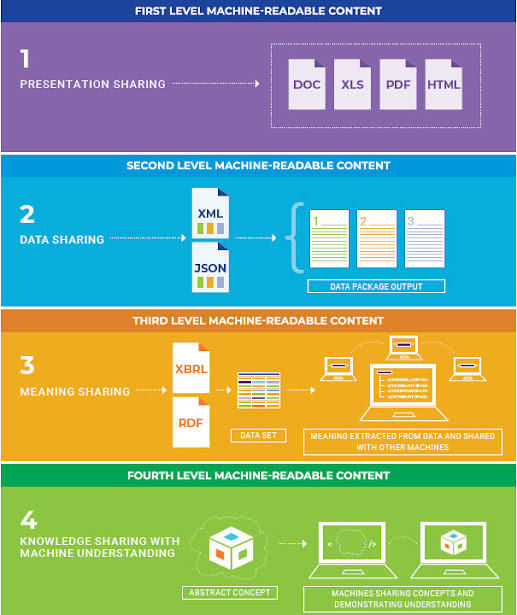Understandability
In their article, Implementing the FDTA: From Data Sharing to Meaning Sharing, the authors Dean Ritz and Timothy Randle, do an excellent job explaining the notion of machine understandability. The graphic below from page 24 of the document and explained on page 23 breaks down the notion of "understandability" into four levels:
- Presentation sharing
- Data sharing
- Meaning sharing
- Knowledge sharing with machine understanding
Being able to differentiate each of these levels is very important to understand the notion of machine understandability. Understanding or comprehending information is a step in a process. The second step is analyzing or accessing the information. Finally, a conclusion can be reached or a decision can be made. Each of these levels is explained in the sections below.
Presentation sharing
Presentation sharing involves the sharing of a digital document using some standard format like PDF, HTML, Excel, OpenDoc such that the document stored on one computer system can be transferred to some other computer system and then a human can read the information in that document. Such documents tend to be formatted for presentation of the information within the document. Sometimes the information contained in these documents can be parsed and then used by some down stream automated processing task; but such processes tend to be brittle and not very reliable.
A computer software application does not really understand what is contained in these documents, but the computer based process can read the digital information which tends to be formatted for presentation of the information to humans.
Summary: Understandable by humans, not understandable by machines, no low-level model, no high-level model.
Data sharing
Data sharing involves the sharing of data that tends to be taken from one context, put into a CSV file, XML file, JSON file, Excel file, or some other such data format and then transferring that file to someone else who will use that data in some other context.
A computer software application can make use of such data sharing files, but humans tend to have to map the data into their specific context. Also, because little thought was put into the issues of sharing this data, there tend to be data type conflicts, meaning conflicts, and other such problems that need to be overcome when trying to make use of such data. Basically, there is no self-describing metadata that describes the data.
Summary: Not understandable by humans, understandable by machines, local or no low-level model, no high-level model.
Meaning sharing
Meaning sharing involves intentionally capturing and sharing not only the physical format of the file but also that semantics or meaning including the context of what is contained within the transferred file. The information shared has enough context so that software can make use of that information effectively. Information formats such as RDF, JSON-LD, XBRL, GSQL, PROLOG, DATALOG, or other such formats are used for the information exchange because those formats have the expressive power to provide the necessary meaning to an information receiver to make effective use of that information. Tends to describe "atoms" and maybe "molecules", but not "assemblies" or "organisms (see the atomic design methodology). Note that self-describing metadata is provided to explain low-level objects, but not high-level objects.
Summary: Not understandable by humans, understandable by machines, global oriented low-level model, no high-level model. (Can be understandable to motivated, technical oriented humans). Interpretable.
Knowledge sharing with machine understanding
Knowledge sharing with machine understanding involves the use of models that help computer software not only read but also understand the meaning of the information shared and then do work on that information. So, not only does the RDF, JSON-LD, XBRL, GSQL, PROLOG, DATALOG, or other format provide "information" that conveys context; high-level models or metamodels are also provided to make available additional context generally using those same technical formats and therefore because of these rich descriptions additional understanding of the information is available to help software processes understand the information even more. Neutral or natural human understandable presentation can be generated from machine-readable representation. (see the atomic design methodology). Note that self-describing metadata is provided to explain both low-level objects and high-level objects such as "organisms" or "assemblies"
Summary: Understandable by humans, understandable by machines, global oriented low-level model, global oriented high-level model. (Can be understandable to business oriented humans).
* * *
Real understanding involves genuinely understanding context. To genuinely understand context you need the level "knowledge sharing machine understandability". Using a report involves safely using information and controlling that information. Genuine understanding and context enables that safety and control.
Note that if digital distributed ledgers are used, two additional levels could be added. Note that near pixel-perfect human understandable presentations are possible using something like Inline XBRL or Microformats (imbedding RDF within HTML).
Additional Information:




Comments
Post a Comment